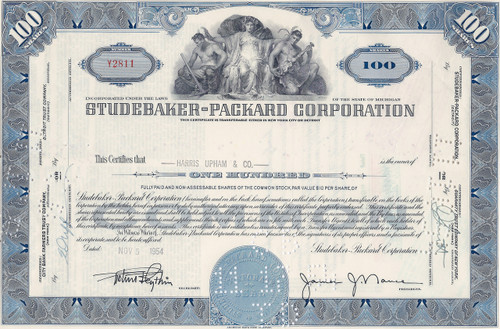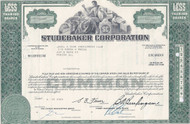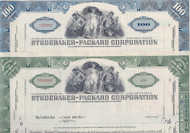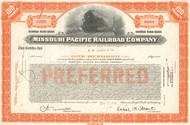Categories
Categories
- Home
- Automotive
- Automakers
- Studebaker-Packard Corporation 1950's
Studebaker-Packard Corporation 1950's
Product Description
Studebaker-Packard Corporation stock certificate 1950's
Very nice vignette of multiple allegorical Greek figures. Blue, green, brown, and a 2-color set available in this listing. This is a fantastic piece for both name of the company and the low price point. Dated in the 1950's.
The Studebaker-Packard Corporation was the entity created by the purchase of the Studebaker Corporation of South Bend, Indiana, by the Packard Motor Car Company of Detroit, Michigan, in 1954. While Studebaker was the larger of the two companies, Packard's balance sheet and executive team were stronger than that of the South Bend company.
In the spring of 1962, Studebaker-Packard reverted its name to Studebaker. The following year the South Bend plant was closed, while its Canadian plant in Hamilton continued to produce Studebaker cars until 1966.
It was hoped that Packard would benefit from Studebaker's larger dealer network. Studebaker hoped to gain through the additional strength that Packard's cash position could provide. Once both companies stabilized their balance sheets and strengthened their product line, the original plan devised by Packard president James J. Nance and Nash-Kelvinator Corporation president George W. Mason was that the combined Studebaker-Packard company would join a combined Nash-Kelvinator Corporation and Hudson Motor Car Company in an all-new four-marque American Motors Corporation.
Had the complicated set of combinations gone through as planned, the new company would have immediately surpassed the Chrysler Corporation to become the third of America's "Big Three" automobile manufacturers. However, the sudden death of Mason in 1954 (succeeded by George W. Romney) and disputes over parts-sharing arrangements between the companies doomed any chance of completing the proposed merger. This failure to combine the companies effectively sealed the fates of all four.
Packard executives soon discovered that Studebaker had been less than forthcoming in all of its financial and sales records. The situation was considerably more dire than Nance and his team were led to believe; Studebaker's break-even point was an unreachable 282,000 cars at a time when the company had barely sold 82,000 cars in 1954. Furthering the new company's problems was the loss of about 30% of Studebaker's dealer network by 1956.
Studebaker-Packard tried a company reorganization in which Studebaker took the part of the volume and commercial car and truck seller from South Bend while Packard was to re-occupy the luxury market - one of Nance's targets since he took over Packard's presidency in 1952. The gap in between was filled by a new make, the Clipper. Technically, it was a lighter Packard, built in Detroit alongside the senior cars. The next generation of cars would have to be concentrated on one location, and there was a detailed program for sharing as much sheet metal as possible. Although Nance was presumably right, dealer resistance against the Clipper as a new entry in the intermediate field was big.[citation needed] Dealers complained that the only thing that allowed them to sell Clippers was the prestige, though declining, of the Packard name on the car itself.
Following a disastrous sales year in 1956, Nance resigned and Studebaker-Packard entered a management agreement with the Curtiss-Wright Corporation. Curtiss, led by Roy T. Hurley, insisted on major changes. All of Studebaker-Packard's defense contracts and plants where defense work was carried out were picked up by Curtiss, Packard production in Detroit was stopped and all remaining automotive efforts were shifted to South Bend.
In 1961 Sherwood Egbert was appointed company president. He was expected to help diversify the company. In the spring of 1962, four years after the last Packard car rolled off the assembly line, and eight years following the merger between Packard and Studebaker, the company dropped 'Packard' from its legal name, which returned to being 'Studebaker Corporation
 Loading... Please wait...
Loading... Please wait... 









